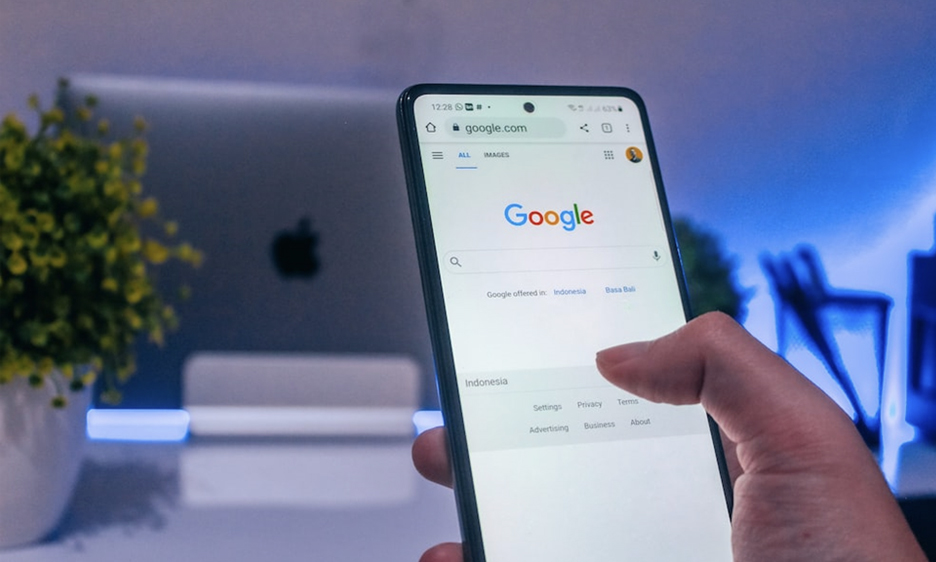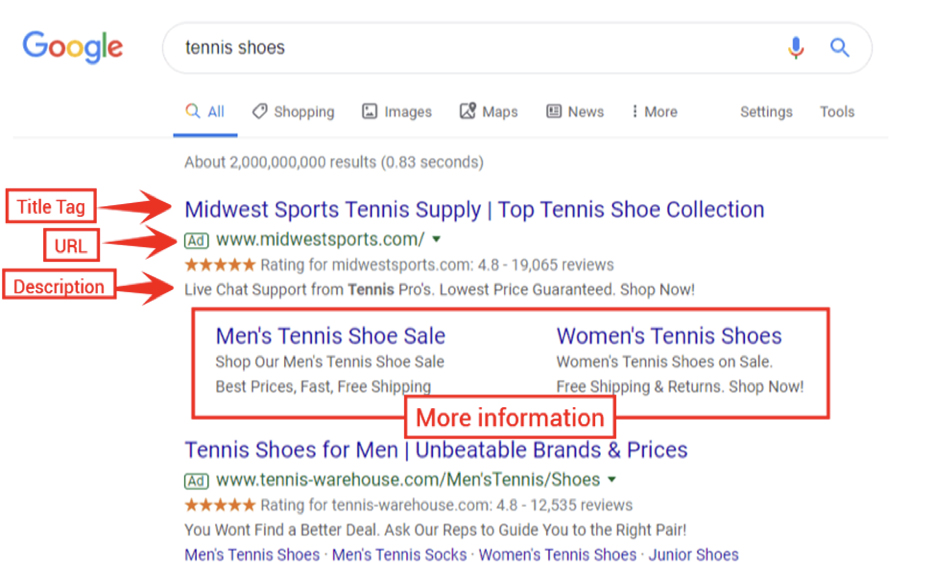
Google Ads: Maximizing Your Advertising Potential
There are billions of queries made on Google every second and Google advertising is displayed on most search results pages. Google Ads, which are purchased by businesses, are an efficient way to bring relevant, qualified traffic to your website precisely at the times when people are looking for the kinds of goods or services your company provides.
Google’s pay-per-click (PPC) platform, known as Google Ads, enables businesses to increase their visibility across Google properties. The most typical Google advertisements ad type is the search ad, which shows up on the SERP for queries related to the advertiser’s goods and services. However, businesses can also use Google Ads to run display advertisements, shopping ads, YouTube ads, and other types of ads.

1. Creating effective ad campaigns using Google Ads
Google Ads could appear to be too much at first. PPC advertising includes a lot of moving pieces, so you want to be sure you produce ads that are successful for your target demographic. Google offers both search and display adverts, so you must be sure to pick the proper one for your campaign.
How then can you develop and manage a successful campaign with Google Ads?
- Set goals
Setting goals is necessary before launching any kind of digital marketing strategy. The situation with your Google Ads campaign is the same. If you’re going to run PPC advertisements, you must set realistic goals for such advertisements.What are you hoping to accomplish with this campaign? Do you want to boost conversions, get more leads, or have a higher click-through rate (CTR)? You may create and accomplish all of these different kinds of objectives with a PPC campaign. You will start the process of understanding Google Ads by establishing the campaign’s goals.
- Figure out your target audience
One of the most crucial components of any Google Ads campaign is your target audience. You must be aware of your target audience for your ads. You must first identify your target demographic because your adverts will be designed to appeal to them. Consider your ideal client when determining your target market. Many companies construct personas for their target audiences in which they generate various types of people. They use these personalities to create campaigns that are tailored to these particular demographics.
- Conduct keyword research
Keywords drive PPC advertisements. These keywords cause the search results to include your advertisement. You must choose the ideal keywords for your campaign while using Google Ads. You must perform keyword research for this. You may find the ideal keywords for your campaign using a variety of research tools. You should concentrate on long-tail keywords while you search for various phrases.These are expressions with three words or more. Since long-tail keywords are more targeted and are more likely to attract quality leads looking for the most pertinent results, they increase traffic to your campaign. Finding long-tail keywords will help you draw in leads that are more qualified and likely to convert.
- Create effective Google Ads
You must produce excellent adverts when using Google Ads. Although it can seem like simple sense, this is an essential component of your advertising strategy. You must design advertisements that encourage viewers to click on them. You must incorporate your keywords into your ad copy first. This guarantees that your advertisement is relevant to your audience’s search.The next step is to write an intriguing headline.Create an intriguing and attention-grabbing headline to entice readers to click on your adverts. The final stage is to instruct your audience on how to proceed. Add a call to action (CTA) to your advertisement to direct viewers to take action and become customers.
- Set your budget
Set your budget before you start your Google Ads campaign. Your campaign’s budget is an essential component because it affects how many leads you can generate and how long your campaign will last. One of the best Google Ads ideas is that running a campaign doesn’t require a specific budget.Setting a budget that works with your funds is simple for your business, whether you’re running a campaign for $100 or $10,000. As you establish your budget, keep in mind your maximum bid. The amount you are willing to spend up to your maximum bid each time someone clicks on your advertisement.
- Update your landing page
You may send your leads to a specific page each time they click on your PPC ad by creating it in Google Ads. Make sure it is updated, whether it is a pricing page or your home page. You don’t want to send visitors to stale pages because this could turn them off as leads.
- Use remarketing to boost conversions
Leads from your Google Ads campaigns are probably going to take some time to convert. They will click on your advertisement and look into your company, but they won’t buy anything. This is commonplace because many consumers deliberate about their purchases more.Remarketed advertising can help you keep these leads thinking about your business so that you don’t lose them. You can set up a remarketing campaign to display them advertising for the goods or services they browsed after they click on your ads. This keeps your company front of mind for them.

2. Utilizing Ad extensions for enhanced visibility
Have you ever seen a Google ad that offers more details than standard search ads? I’m trying to say that it contains more details than just the title tag, URL, and description.
On a website, you could occasionally notice a phone number or links to other pages. Ad extensions are the name for these added functionalities. They come highly recommended by PPC professionals, and with good cause. According to Google, ad extensions can increase click-through rates for advertisements by a typical 10% to 15%. That could really benefit your campaign!
Ad extensions take up more space in search results, emphasising your adverts while relegating rival ads or organic listings to the bottom of the SERPs. Additionally, you’re receiving more value for your money because ad extensions enable you to include additional information in your advertising.

How do you set up ad extensions in Google Ads?
There are several options available when deciding which ad extensions are most effective for your company. In this video, I’ll go over every single Google ad extension. For Google Ads (formerly Google AdWords) to set up ad extensions:
- Log into your Google Ads account.
- Next, you’ll want to go to the “Extensions” page on your account and click the button to add extensions.
- Finally, choose which ad extension you want to use. Each one needs different information about your business to create a good experience with users interacting with your ad. I’ll detail all of the different ad extensions in the next section.
Types of ad extensions
- Structured snippet extensions
Structured snippet extensions let you call attention to your unique products and services. When setting up your structured snippet extension, you’ll see a list of available categories, including:

- Amenities you offer
- Brands you sell
- Courses or degree programs you offer
- Destinations people can visit
In order to showcase your MBA programme, hospitality management, marketing, or any other degree programmes relevant to your business department, you can add an addition to your university’s advertisement for its business degree programmes. According to Google, you should aim for four values in each header. Therefore, once more, if you’re a university promoting its business degree programmes, you’ll see a header that reads « Degree programmes, » followed by a listing of at least four programmes.
- Callout extensions
Callout extensions let you highlight the things that make your business stand out. You can emphasize the fact that your plumbing business offers round-the-clock service in a callout extension. As you dive down from the campaign level to the specific ad group level, Google advises making your callouts more targeted. You should make the callout more specific to what you are advertising if you are advertising a unique package deal at the ad group level.You can wish to emphasizes that your offer is the best value in the region or that it comes with a full bundle. Google will only display a total of 10 callouts beside your ad. - Call extensions
They are precisely what they sound like: call extensions. By clicking your advertisement, they make it simpler for someone to call you. If you include a call extension in your advertisement, users who are using mobile devices will notice a button they can click to dial your number. They will still be able to see your phone number and navigate to your website if they are viewing your advertisement on a phone that is unable to place calls. Therefore, you can leave a phone number to encourage people to contact you by clicking the button in your advertisement if you run a clothes store and want them to call to schedule fittings or with any inquiries. - Message extensions
Message extensions, like call extensions, give people a chance to contact you from your ad. These are meant for mobile users with the ability to communicate via text messages. Your business has to utilize a number that can send and receive texts if you’re using message extensions. You can configure these so that your response includes a phone number or email address. If you reply via email, the consumer will see it as a text message.
- Price extensions
These are especially great if you’re an e-commerce or brick-and-mortar store looking to highlight deals or any costs associated with what you sell. You can also use price extensions if you want to advertise the cost of services you offer.
- Location and affiliate location extensions
Location extensions tell people where they can go to find your store or location. An affiliate location extension lets people know who sells your product. This is good for when you make a product that gets sold by vendors in a number of locations.
- App extensions
App extensions give people who see an ad for your app the option to go to their respective app store to download your app. These appear on mobile devices where people can download your mobile app. Remember that app extensions are used in addition to your ad. The main focus of your ad would be to draw people to your website.
- Promotion extensions
These ad extensions let you feature certain deals your business is running with your ad. When employing a promotion extension, consider the major promotions your company is running and the best times to advertise them. Because of the change in seasons, are you providing a significant discount on clothing? Where would you feel the effects the most?
3. Implementing remarketing
Remarketing, often referred to as retargeting, is a very popular and frequent type of digital marketing in which advertisers show advertisements to people who have visited their website or a certain web page and have either taken or have not performed a particular action. The folks who have already expressed interest in your company or brand might be effectively targeted in this way.
The term « re »-marketing refers to the practise of focusing on previous visitors or current clients. Consider it a second chance to use online advertising or marketing initiatives to convert, upsell, or retain customers. Remarketing can be done in a variety of methods and with a variety of ad platforms, including Facebook, Google, and Outbrain.
Any marketer’s playbook MUST include remarketing, regardless of how you employ it.

How Does Remarketing Operate?
Setting up a remarketing campaign for your website is simple. It needs the installation of pixels.
A specific ad network will give you a little piece of code (known as a pixel tag) to add to your website when you launch a campaign with them. The code will leave an anonymous browser cookie on the user’s browser each time they visit your website and add them to your retargeting list. The system will offer your ad to this specific user when they visit another website that hosts native or display adverts from your ad network supplier. As long as you are running a campaign, this will happen.
Google’s decision to stop allowing the use of third-party cookies will impact the ability of marketers to remarket. That’s why it is important to advertise on platforms based on the use of first-party data that allows tracking. The cookieless world is already happening, so start planning now for tools and tactics that will allow you to remarket in the future.
Let’s have a look at five different ways to remarket that are worth implementing right away.
- Benefit from Google Analytics
Google Analytics is a fantastic tool for businesses wanting to launch a remarketing plan because it enables the creation of user lists based on users’ online behaviors. For instance, Google Analytics enables the development of lists based on a variety of criteria, including time spent on a website, page views, departure pages, and the accomplishment of goals.
- Cross-channel marketing
One of the most crucial sales precursors is without a doubt creating a memorable, top-of-mind brand. People like to purchase products from brands that they are familiar with and have already encountered online. By showing adverts to previous website visitors across several platforms, the idea of cross channel advertising enables businesses to reduce the amount of time it takes to establish a recognizable brand.For example, if a user visits a website after clicking an advertisement on Google, the cross-channel advertising theory suggests advertising to that user when he logs in to Facebook and Twitter and when he visits other websites that allow for the display of adverts.
- Use remarketing for search
Businesses can target individuals who have previously visited their website as they search for any specific keyword on Google using remarketing for search. Businesses can choose broader keywords for a remarketing for search campaign because we are targeting past website visitors.Remarketing for search has shown out to be one of the most successful campaigns for businesses in terms of cost per acquisition, according to studies Google has just told me about.
- Remarketing for ecommerce businesses
It will be challenging for companies with thousands of goods to make a banner for each one. Dynamic remarketing advertisements are an option that is provided by both Google and Facebook, and they are quite effective.For dynamic remarketing advertisements, Google presently permits the use of its templates, but it has informed us that it is working on a system that will allow advertisers to upload their own unique dynamic banners.
- Remarket on YouTube
Google AdWords is used to design and manage YouTube adverts. This implies that they are able to use AdWords audiences, including those made in Google Analytics.YouTube permits banner and video advertising. Although there are less hits to the website from video advertisements, they are more likely to increase branding and visibility. On the other hand, banner advertising result in more website clicks but less branding.
4. Optimizing Landing pages for higher conversion rates
The practise of enhancing web page design and layout with the aim of boosting conversions, enhancing the user experience (UX), and converting more visitors into devoted clients is known as landing page optimisation. LPO, a branch of conversion rate optimization (CRO), tries to increase the performance of landing pages by making them more engaging and focused.
A landing page that has been optimized provides your visitors with pertinent information coupled with the ideal ratio of style and functionality to entice them to convert.

The 3 stages of landing page optimization
- Identify potential problems with the landing page’s design or functionality
Point out specific problems with the user experience that contribute to low conversion rates and a high bounce rate so you can change them for the better.
- Use controlled experiments, or A/B tests, to test page improvements
Test different page elements—such as headlines, copy, images, fonts, forms, and calls to action (CTAs)—to determine which combination works best for achieving your goals.
- Measure the effect on the page’s conversion rate to track the success of your optimization efforts
Analyzing user data can help you understand what elements influence conversion rate so you can split test additional changes to increase your success.
The benefits of optimizing your landing page
Landing pages provide a lot of value when it comes to digital marketing strategy, both for the marketers who build them and the audience you’re attempting to target.
You may increase the effectiveness of your landing page and realize the full potential of your marketing efforts by making a few small adjustments. Utilizing actionable landing page best practices allows you to fill the funnel with prospects who can benefit from and complete their jobs-to-be-done (JTBD) using your software, product, or offer. This results in:
- Enhanced user experience: optimizing your landing pages to provide more useful, well-structured, relevant content and interactions with visitors leads to a more satisfying and delightful experience for them.
- Conversion optimization: LPO ensures you achieve the highest possible conversion rate—reflected in ecommerce sales or lead generation—from the visitors who arrive on that landing page.
- Lower customer acquisition costs: by providing more value for targeted visitors and an optimized user experience, LPO also contributes to a lower cost-per-click (CPC) and a decrease in your overall customer acquisition costs (CAC).

How to optimize your landing page
Now that we’ve seen why landing page optimization is important, let’s move on to some best practices that can lead to better conversion rates!
- Test out landing page headlines with different value propositions
For new audiences, landing pages are a terrific location to define your unique selling propositions (USPs), especially if we’re talking about a single product-specific landing page. You want visitors to your website to understand clearly why they should pick your product over that of your rivals.Because of this, it’s crucial that your landing page’s header prominently states your USP. To determine which value propositions are most effective, you should test out a variety of them.
- Personalize your welcome messages based on country
With the aid of personalization, you may send pertinent one-to-one messages to welcome visitors to your website.Customizing your welcome popups to suit the nation that your international visitors are browsing from is a terrific method to achieve this. This is a fantastic chance to describe your local shipping regulations or your free shipping promotions.
- Display social proof
You can use personalization to welcome visitors to your website with pertinent one-to-one messaging.The country that your foreign visitors are browsing from can be reflected in your welcome popups, which is a terrific approach to achieve this. This presents a wonderful opportunity to describe your local shipping regulations or your free shipping promotions.
- Decrease your landing page load time
Visitors anticipate a rapid load time when they land on your landing page. According to studies, you just have three seconds to make an impression on your visitors.By optimizing your landing page’s pictures, videos, and general layout, you may reduce load time. Making your landing page load as soon as possible is made possible by many landing page optimisation solutions.
- Use a clear, simple layout
Avoid going overboard while building your landing page. Your design should be concise and easy to understand. Keep your copy brief and uncomplicated, and make good use of white space.As there shouldn’t be any confusion when visitors transition from your landing page to your main website, you also want to make sure that all of the items on your landing page are consistent with your brand.
- Use clear (and personalized) call-to-action buttons
Your landing page’s sole objective, as previously established, is to persuade visitors to click the call-to-action button. Your CTA should be visible above the fold and stand out from the rest of the page visually. Also, you should almost always use just one CTA.Also, you may customize your call-to-action to increase conversion rates by using information about your website visitors.
- Use analytics to track and measure your landing page performance
Not least, it’s critical to monitor and assess the effectiveness of your landing pages. Your landing page’s total conversion rate is important, but you also need to consider how well it converts for certain user groups. For one subset of your target market, a landing page might perform exceptionally well, but terribly for another.Using analytics enables you to continue to refine your landing pages in the future while making data-driven decisions.
Page optimization tools to use
Since landing pages are used towards the bottom of the conversion funnel, even the slightest change can contribute to a major increase in your conversion rate and profit over time.
But marketers often struggle with understanding landing page performance and how to optimize for the better. Luckily, there are many landing page optimization tools designed to help you measure, improve, and perfect your landing pages. We’ve put together a list of the best landing page optimization tools to maximize conversions.
Top landing page optimization tools include:
- Unbounce
- Instapage
- Hotjar
- Optimizely
- LeadPages
- Popupsmart
- CrazyEgg
- Five Second Test
In conclusion,
Given its power and reach, Google AdWords ought to be a component of any paid campaign. Follow the advice we provided to get going, and keep in mind to tweak and improve as you go.
There are just campaigns that require a little bit more work; there are no Google Adwords campaigns that don’t work. You have all you need to establish a productive Google Ad campaign that generates clicks and leads by using the aforementioned approach and information.










